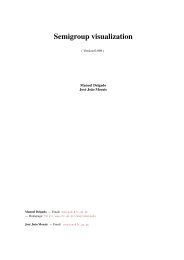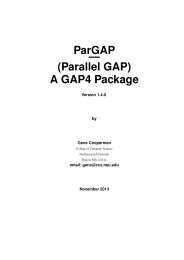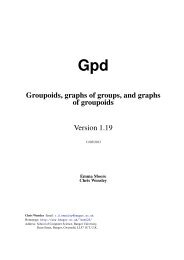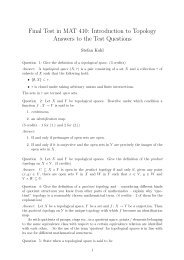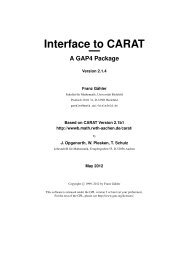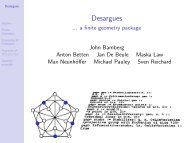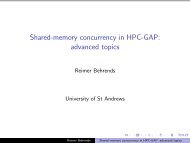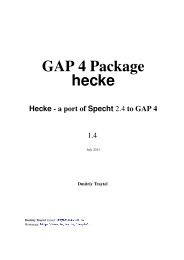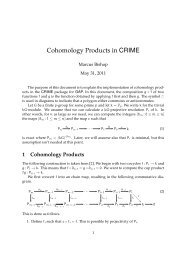guava - Gap
guava - Gap
guava - Gap
Create successful ePaper yourself
Turn your PDF publications into a flip-book with our unique Google optimized e-Paper software.
Chapter 4<br />
Codes<br />
A code is a set of codewords (recall a codeword in GUAVA is simply a sequence of elements of a<br />
finite field GF(q), where q is a prime power). We call these the elements of the code. Depending on<br />
the type of code, a codeword can be interpreted as a vector or as a polynomial. This is explained in<br />
more detail in Chapter 3.<br />
In GUAVA, codes can be a set specified by its elements (this will be called an unrestricted code),<br />
by a generator matrix listing a set of basis elements (for a linear code) or by a generator polynomial<br />
(for a cyclic code).<br />
Any code can be defined by its elements. If you like, you can give the code a name.<br />
Example<br />
gap> C := ElementsCode(["1100", "1010", "0001"], "example code", GF(2) );<br />
a (4,3,1..4)2..4 example code over GF(2)<br />
An (n,M,d) code is a code with word length n, size M and minimum distance d. If the minimum<br />
distance has not yet been calculated, the lower bound and upper bound are printed (except in the case<br />
where the code is a random linear codes, where these are not printed for efficiency reasons). So<br />
a (4,3,1..4)2..4 code over GF(2)<br />
means a binary unrestricted code of length 4, with 3 elements and the minimum distance is greater<br />
than or equal to 1 and less than or equal to 4 and the covering radius is greater than or equal to 2 and<br />
less than or equal to 4.<br />
Example<br />
gap> C := ElementsCode(["1100", "1010", "0001"], "example code", GF(2) );<br />
a (4,3,1..4)2..4 example code over GF(2)<br />
gap> MinimumDistance(C);<br />
2<br />
gap> C;<br />
a (4,3,2)2..4 example code over GF(2)<br />
If the set of elements is a linear subspace of GF(q) n , the code is called linear. If a code is linear, it<br />
can be defined by its generator matrix or parity check matrix. By definition, the rows of the generator<br />
matrix is a basis for the code (as a vector space over GF(q)). By definition, the rows of the parity<br />
check matrix is a basis for the dual space of the code,<br />
C ∗ = {v ∈ GF(q) n | v · c = 0, f or all c ∈ C}.<br />
26



